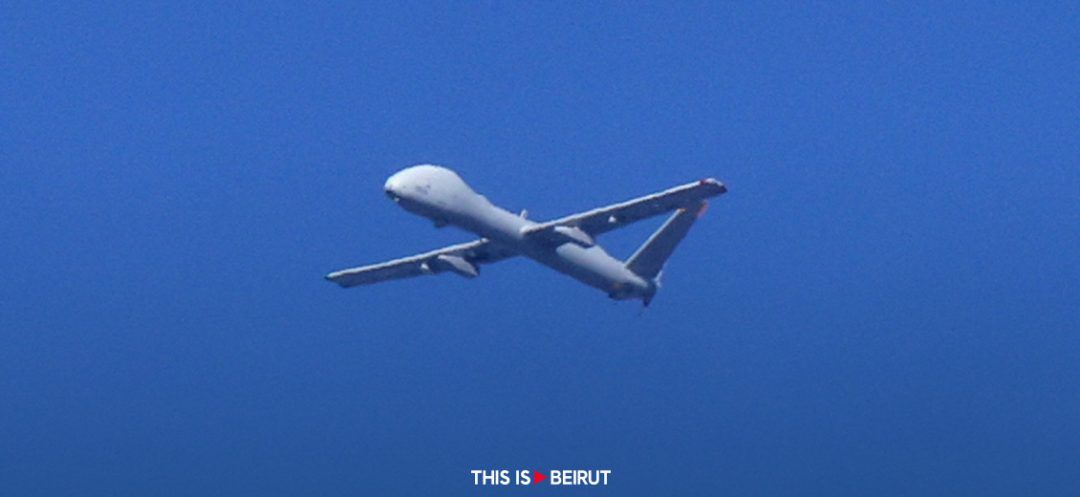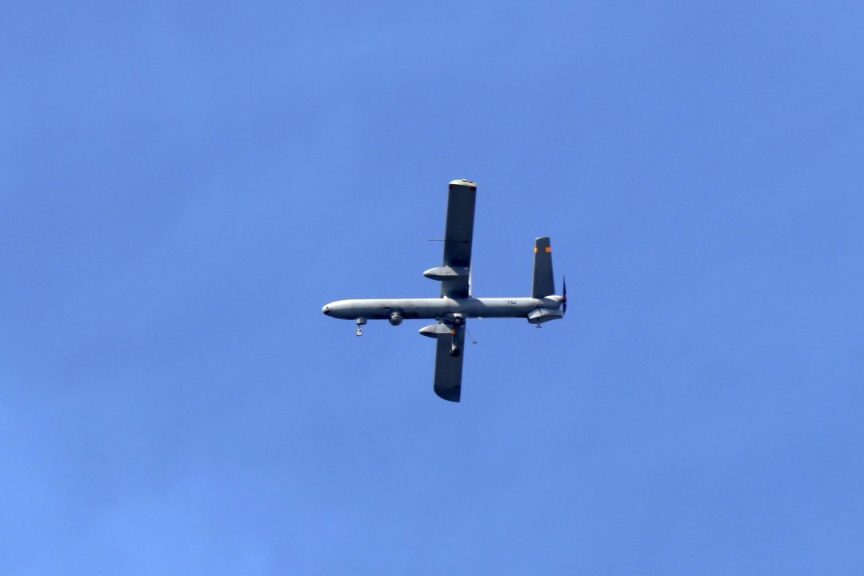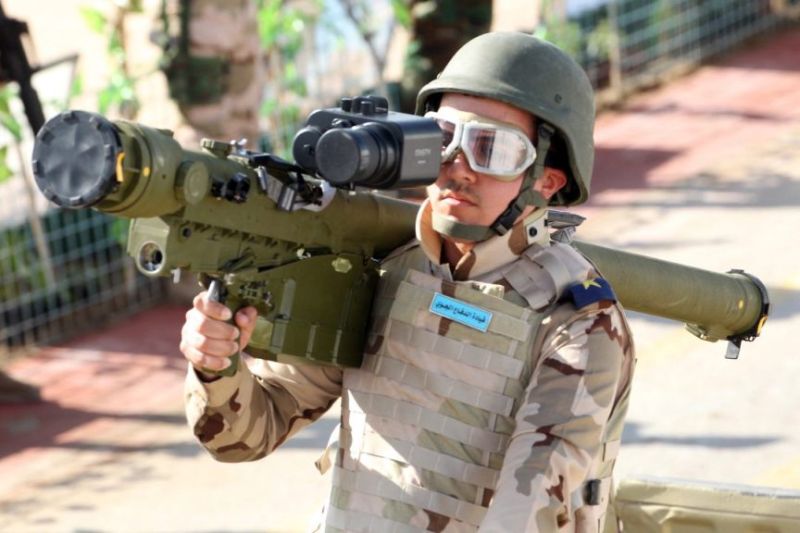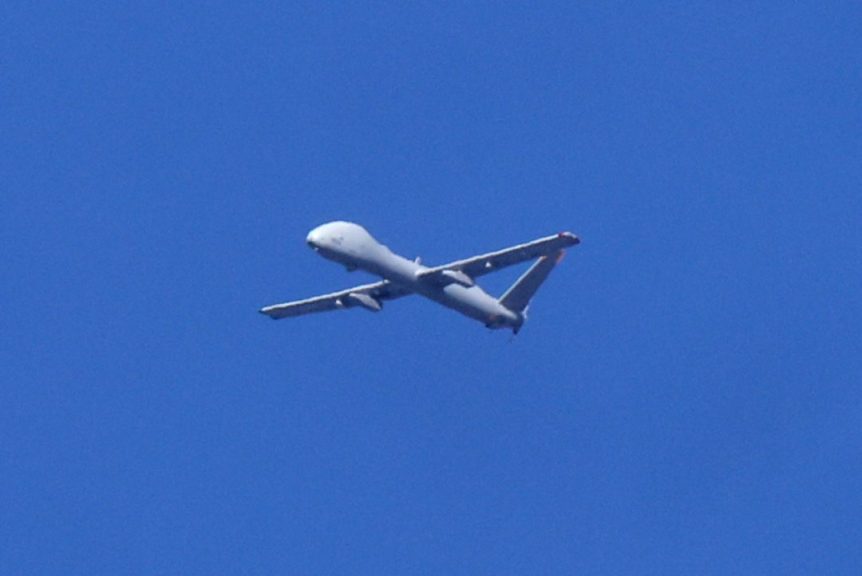- Home
- War in the Middle East
- Lebanese Skies Are Becoming Increasingly Dangerous for Israel

©(JACK GUEZ / AFP)
Since the start of the Israel-Hamas war, a "cat-and-mouse game" between Israeli drones and Hezb air defense has steadily emerged in Lebanese skies. As a new Israeli drone was shot down on Monday, Ici Beyrouth takes a look at the main equipment involved.
On Monday, Israeli forces reported the interception of one of their drones above the village of Aaishiyeh in the town of Jezzine, approximately 13 kilometers from the Israeli border. It was shot down during the night by a surface-to-air missile fired by Hezbollah. The latter, which targeted an Elbit Hermes 450 drone, promptly claimed responsibility for the incident early in the morning.
The pro-Iranian faction previously downed similar aircraft since the beginning of the border clashes. In fact, on February 26, another drone was destroyed in flight using similar means. Additionally, a more recent model, the Hermes 900, was shot down over the region of Baalbeck on April 7.
[readmore url="https://thisisbeirut.com.lb/lebanon/242512"]
The Trailblazing Hermes 450
Developed and introduced in 1998 by the Israeli company Elbit Systems in collaboration with the British defense industry, the Hermes 450 drone falls into the category of Medium-Altitude Long-Endurance (MALE) drones. With a wingspan of 10.5 meters and a maximum takeoff weight of 450 kilograms, it can fly up to an altitude of 5,500 meters for 20 hours at a maximum speed of 150 kilometers per hour, according to information disclosed by its developer. Its price is estimated at around $2 million.
 This photo taken in southern Israel shows an Israeli military drone flying over the Gaza Strip on March 14, 2024, during the ongoing conflict between Israel and Hamas. (JACK GUEZ / AFP)
This photo taken in southern Israel shows an Israeli military drone flying over the Gaza Strip on March 14, 2024, during the ongoing conflict between Israel and Hamas. (JACK GUEZ / AFP)
It is mainly used for surveillance, reconnaissance, intelligence gathering, communication relay, as well as for attack missions. In the context of its operations, its payload – the equipment it can carry under its wings – is approximately 180kg, according to Elbit Systems.
This can include various types of electro-optical, infrared or hyperspectral sensors, pods for electronic intelligence, communication or electronic warfare, a radar for target tracking, as well as small-sized bombs or missiles.
While the Israeli military has neither confirmed nor denied whether the Hermes 450 transports weapons, numerous consistent testimonies attest to its ability to do so. The most recent widely publicized example of such use was the strike on the workers of the NGO World Central Kitchen (WCK) in Gaza on April 1, according to reports by Haaretz and The Guardian.
[readmore url="https://thisisbeirut.com.lb/israel-hamaswar/240868"]
Its self-reliance allows it to conduct missions within a radius of 300km and under various conditions. Its modular design enables easy adaptation to different environments and missions, while its operational reliability makes it a preferred tool not only for the Israeli military, but also worldwide. In fact, the Hermes 450 is among the most exported systems in its category.
How Was It Shot Down?
Currently, it remains difficult to determine which weapon was used to destroy the aforementioned drone. This ambiguity is compounded by Hezbollah's silence regarding its actual capabilities.
Indeed, most of Hezbollah’s anti-aircraft missile systems only provide a relatively limited protection zone. However, they compel Israeli aircraft to fly at higher altitudes, reducing Israel's ability to accurately strike ground-based targets. Most of these systems are of Soviet or Iranian origin.
[readmore url="https://thisisbeirut.com.lb/israel-hamaswar/198868"]
According to the American think tank Center for Strategic and International Studies (CSIS), the majority of Hezbollah's anti-aircraft arsenal consists of portable systems, such as the Russian Igla or the Iranian Misagh.
Also known as MANPADS (Man-Portable Air-Defense Systems), these weapons, which have limited capacities due to their size, are mainly designed for low-altitude and short-range defense. In fact, their range seldom exceeds 5km.
 (ARCHIVES) A member of the Iraqi army carries a man-portable air defense system (MANPADS) as he stands on a vehicle during an annual military parade, 1ᵉʳ February 2015, in the capital Baghdad. (Sabah ARAR / AFP)
(ARCHIVES) A member of the Iraqi army carries a man-portable air defense system (MANPADS) as he stands on a vehicle during an annual military parade, 1ᵉʳ February 2015, in the capital Baghdad. (Sabah ARAR / AFP)
The downing of the Hermes 450 by a MANPADS remains a plausible scenario. The mountainous terrain of the region, coupled with the limited performance of the aircraft, especially in terms of altitude, may have contributed to such a successful outcome.
It should be mentioned that, according to Israeli intelligence, Hezbollah is believed to have acquired several much more sophisticated air defense systems, and its members have been trained to use them in Syria. Among the alleged systems owned by the Shiite party are the Osa and, notably, the Buk, with a range of around 50km.
Next in Line: The Hermes 900
In recent years, the Israeli military has privileged the Hermes 900 Kochav over the 450 model, another Medium-Altitude Long-Endurance (MALE) drone, introduced by the same developer in 2012. With a wingspan of nearly 16 meters and a maximum takeoff weight of 1,100 kilograms, it is more impressive than its predecessor. Moreover, it is more expensive: according to the specialized magazine Janes, its price ranges between $6.8 million and $8.8 million.
 A photo taken from the Israeli side of the border with the Gaza Strip on October 30, 2023, shows an Israeli military drone flying over the northern Gaza Strip during fighting between Israel and Hamas (JACK GUEZ / AFP).
A photo taken from the Israeli side of the border with the Gaza Strip on October 30, 2023, shows an Israeli military drone flying over the northern Gaza Strip during fighting between Israel and Hamas (JACK GUEZ / AFP).
Just like its "older" brother, the Hermes 900 incorporates a range of sensors, as well as the same instruments and armaments under its wings. However, its payload (350kg) is significantly more considerable.
Furthermore, it offers a flight endurance of over 30 hours and a maximum altitude of 9,000 meters. In Lebanon's context, this new version provides a significant advantage. In fact, its limit grants it the ability to circumvent most of the air defense systems used by Hezbollah, notably the famous MANPADS... but not those with a more advanced range.
On Monday, Israeli forces reported the interception of one of their drones above the village of Aaishiyeh in the town of Jezzine, approximately 13 kilometers from the Israeli border. It was shot down during the night by a surface-to-air missile fired by Hezbollah. The latter, which targeted an Elbit Hermes 450 drone, promptly claimed responsibility for the incident early in the morning.
The pro-Iranian faction previously downed similar aircraft since the beginning of the border clashes. In fact, on February 26, another drone was destroyed in flight using similar means. Additionally, a more recent model, the Hermes 900, was shot down over the region of Baalbeck on April 7.
[readmore url="https://thisisbeirut.com.lb/lebanon/242512"]
The Trailblazing Hermes 450
Developed and introduced in 1998 by the Israeli company Elbit Systems in collaboration with the British defense industry, the Hermes 450 drone falls into the category of Medium-Altitude Long-Endurance (MALE) drones. With a wingspan of 10.5 meters and a maximum takeoff weight of 450 kilograms, it can fly up to an altitude of 5,500 meters for 20 hours at a maximum speed of 150 kilometers per hour, according to information disclosed by its developer. Its price is estimated at around $2 million.
 This photo taken in southern Israel shows an Israeli military drone flying over the Gaza Strip on March 14, 2024, during the ongoing conflict between Israel and Hamas. (JACK GUEZ / AFP)
This photo taken in southern Israel shows an Israeli military drone flying over the Gaza Strip on March 14, 2024, during the ongoing conflict between Israel and Hamas. (JACK GUEZ / AFP)It is mainly used for surveillance, reconnaissance, intelligence gathering, communication relay, as well as for attack missions. In the context of its operations, its payload – the equipment it can carry under its wings – is approximately 180kg, according to Elbit Systems.
This can include various types of electro-optical, infrared or hyperspectral sensors, pods for electronic intelligence, communication or electronic warfare, a radar for target tracking, as well as small-sized bombs or missiles.
While the Israeli military has neither confirmed nor denied whether the Hermes 450 transports weapons, numerous consistent testimonies attest to its ability to do so. The most recent widely publicized example of such use was the strike on the workers of the NGO World Central Kitchen (WCK) in Gaza on April 1, according to reports by Haaretz and The Guardian.
[readmore url="https://thisisbeirut.com.lb/israel-hamaswar/240868"]
Its self-reliance allows it to conduct missions within a radius of 300km and under various conditions. Its modular design enables easy adaptation to different environments and missions, while its operational reliability makes it a preferred tool not only for the Israeli military, but also worldwide. In fact, the Hermes 450 is among the most exported systems in its category.
How Was It Shot Down?
Currently, it remains difficult to determine which weapon was used to destroy the aforementioned drone. This ambiguity is compounded by Hezbollah's silence regarding its actual capabilities.
Indeed, most of Hezbollah’s anti-aircraft missile systems only provide a relatively limited protection zone. However, they compel Israeli aircraft to fly at higher altitudes, reducing Israel's ability to accurately strike ground-based targets. Most of these systems are of Soviet or Iranian origin.
[readmore url="https://thisisbeirut.com.lb/israel-hamaswar/198868"]
According to the American think tank Center for Strategic and International Studies (CSIS), the majority of Hezbollah's anti-aircraft arsenal consists of portable systems, such as the Russian Igla or the Iranian Misagh.
Also known as MANPADS (Man-Portable Air-Defense Systems), these weapons, which have limited capacities due to their size, are mainly designed for low-altitude and short-range defense. In fact, their range seldom exceeds 5km.
 (ARCHIVES) A member of the Iraqi army carries a man-portable air defense system (MANPADS) as he stands on a vehicle during an annual military parade, 1ᵉʳ February 2015, in the capital Baghdad. (Sabah ARAR / AFP)
(ARCHIVES) A member of the Iraqi army carries a man-portable air defense system (MANPADS) as he stands on a vehicle during an annual military parade, 1ᵉʳ February 2015, in the capital Baghdad. (Sabah ARAR / AFP)The downing of the Hermes 450 by a MANPADS remains a plausible scenario. The mountainous terrain of the region, coupled with the limited performance of the aircraft, especially in terms of altitude, may have contributed to such a successful outcome.
It should be mentioned that, according to Israeli intelligence, Hezbollah is believed to have acquired several much more sophisticated air defense systems, and its members have been trained to use them in Syria. Among the alleged systems owned by the Shiite party are the Osa and, notably, the Buk, with a range of around 50km.
Next in Line: The Hermes 900
In recent years, the Israeli military has privileged the Hermes 900 Kochav over the 450 model, another Medium-Altitude Long-Endurance (MALE) drone, introduced by the same developer in 2012. With a wingspan of nearly 16 meters and a maximum takeoff weight of 1,100 kilograms, it is more impressive than its predecessor. Moreover, it is more expensive: according to the specialized magazine Janes, its price ranges between $6.8 million and $8.8 million.
 A photo taken from the Israeli side of the border with the Gaza Strip on October 30, 2023, shows an Israeli military drone flying over the northern Gaza Strip during fighting between Israel and Hamas (JACK GUEZ / AFP).
A photo taken from the Israeli side of the border with the Gaza Strip on October 30, 2023, shows an Israeli military drone flying over the northern Gaza Strip during fighting between Israel and Hamas (JACK GUEZ / AFP).Just like its "older" brother, the Hermes 900 incorporates a range of sensors, as well as the same instruments and armaments under its wings. However, its payload (350kg) is significantly more considerable.
Furthermore, it offers a flight endurance of over 30 hours and a maximum altitude of 9,000 meters. In Lebanon's context, this new version provides a significant advantage. In fact, its limit grants it the ability to circumvent most of the air defense systems used by Hezbollah, notably the famous MANPADS... but not those with a more advanced range.
Read more





Comments